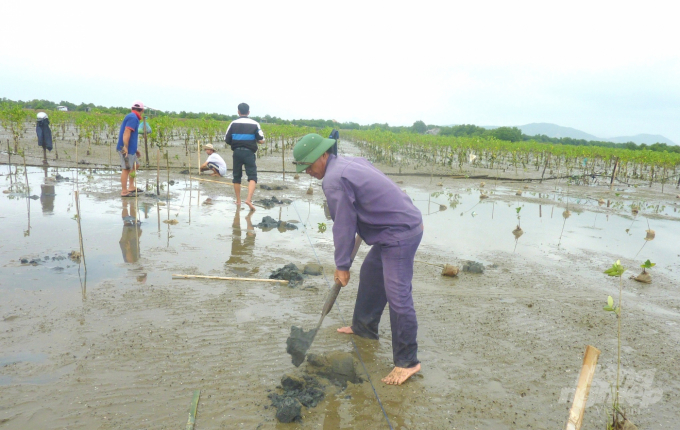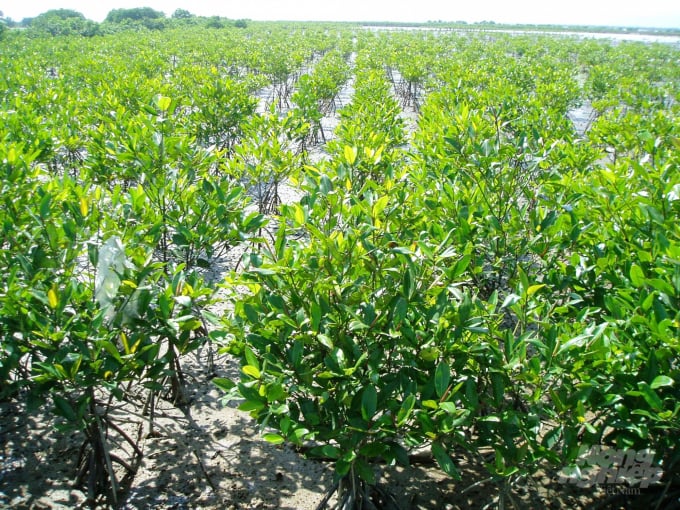October 28, 2025 | 14:32 GMT +7
October 28, 2025 | 14:32 GMT +7
Hotline: 0913.378.918
October 28, 2025 | 14:32 GMT +7
Hotline: 0913.378.918
The Binh Dinh People’s Committee in late 2010 approved a plan on restoring and protecting more than 460 ha of mangrove forests between 2010 and 2020.
Accordingly, the province targeted to plant an additional over 390 ha of mangrove and protect the existing 70 ha of mangrove. Of the planned mangrove forests, nearly 240 ha is located in Thi Nai Lagoon and the other 221.8 ha is in De Gi lagoon.
According to Binh Dinh Province’s Agriculture Promotion Centre, before the mangrove forest restoration project was approved, mangrove forest was only seen in Con Chim Ecological Zone in Phuoc Son Commune, Tuy Phuoc District in Binh Dinh Province.
For the last ten years, under the project, the province’s mangrove forest area has been expanded.
The Government grew the mangrove forests and nursed them for the first five years. After that, the forests were given to local people for management and protection.
Until now, the mangrove forest grew well and contributed to preventing erosion, keep land, protect the environment and increase biological diversity.

People grow mangrove forest in the central province of Binh Dinh. Photo: Vu Dinh Thung.
Before 2016, 32.7 ha of mangrove forest was allocated to local households for protection. However, some households illegally exploited aquaculture products there, damaging the mangrove forest.
In 2016, violations were cracked down and the affected mangrove forest was transferred to the province’s Agriculture Promotion Centre.
Seeing the benefits that the restoration of mangrove forests has brought, many households living around Thi Nai and De Gi lagoons have joined in protecting the forest.
Duong Van Tuong, from Diem Van Hamlet, Phuoc Thuan Commune said that in the past, some people damaged small mangrove trees to facilitate their fishing because of a poor understanding of the mangrove forest’s benefits.
“Such wrongdoing no longer happens,” he said.
“My family received 3 ha of mangrove forest to take care and protect. Now, the trees are over 4 metres,” he said.
Thanks to mangrove forests, more fishes and shrimp came and the fishermen had their income increased, he said.
“We now all joint protecting mangrove forest as it helps ensure our livelihood,” he said.

Mangrove forest growing well in Binh Dinh. Photo: Vu Dinh Thung.
During the period 2021-2025, Binh Dinh Province plans to grow an additional 10 ha of mangrove forest. The province authorities would give about 55.41 ha to local households for protection.
Truong Xuan Dua, head of the Agricultural Technical Research and Application Division under the Binh Dinh Agriculture Promotion Centre said that they were concentrating on caring for and protecting the existing mangrove forests.
The division also studied varieties of nipa and cork oak from Con Chim Ecological Area for growing in a trial in other areas to diversify mangroves forests along lagoons in Binh Dinh province.

The central province of Binh Dinh has seen positive results of a ten-year project on mangrove forest restoration and protection. Birds, fish and other aquaculture species are flocking to restored mangrove forests in Thi Nai and De Gi lagoons. Photo: Vu Dinh Thung.
Tran Quang Nhut, vice director of Binh Dinh Agriculture Promotion Centre said that the centre was developing models that combine mangrove forestation and aquaculture farming.
The models will expectedly harmonise the economic and environmental benefits of mangrove forests.
At the same time, they would develop mechanisms to change jobs for people who earn their living through fishing on coastal alluvial grounds to reduce pressure on mangrove care and protection.
The centre would continue to study and apply models that support people’s livelihood in association with the protection and development of mangrove ecosystems, he said.
The centre also improves research and development of scientific and technical advances to create varieties of mangroves with high adaptability to the conditions at the planting site.
Translated by Hien Anh

(VAN) The Integrated Plant Health Management (IPHM) helps farmers in Quang Ngai increase rice production efficiently and sustainably.

(VAN) Developing low-emission cultivation technology packages, MRV system, strengthening multi-stakeholder cooperation are to realize the goal of low-emission crop production.
/2025/10/23/5928-2-194850_964.jpg)
(VAN) The 'Regenerative cocoa production to support livelihood development in Vietnam' (ReCoPro) project marks an important step toward sustainable cocoa production.

(VAN) Reducing antibiotic dependence in livestock production helps protect public health, enhance food safety, and promote sustainable agricultural development.

(VAN) Experts describe Viet Nam as a 'policy laboratory' within ASEAN, where new agroecological, green finance, and risk-management initiatives are being piloted before wider regional adoption.

(VAN) Limiting rice straw burning and reusing agricultural by-products as materials or fertilizers not only improves soil health but also helps clean the air.

(VAN) ASSET delivers long-term vision and strategy, innovative models, learning networks, policy impact, and measurable environmental benefits.